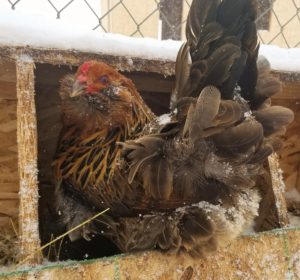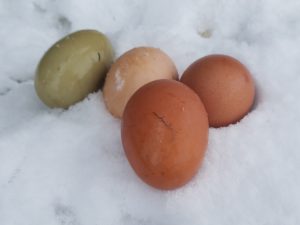
This is my Dr Seuss chicken, she lays green eggs for Sam I Am
I know it seems weird to have a post based solely on eggs, but this is a food website and eggs are a super food. I’m not sure if they have them on Krypton, maybe theirs have red yolks, but they do pack a powerful punch of protein, a little over 6 grams per large egg, and that’s the store bought white chicken eggs.

Two welsummer eggs, an olive ameraucana egg, and a tan buff orpington egg
Chicken Eggs
Not all chicken eggs are created equal, neither are all chickens for that matter. Some lay better than others, some eggs are larger, different colors, and richer flavor.
For quantity you really can’t beat a Black Australorp, one of these set a world record on number of eggs at an amazing 364 eggs in a year. That’s almost exactly one a day, pretty awesome. Most laying breeds will average 3-4 per week so maybe 200 a year. White Leghorns also lay a lot but I’m not a fan of the plain white eggs.

Black Australorp
For quality James Bond says go with Marans, hey if they are good enough for 007 they are good enough for me. Marans lay a beautiful dark chocolate egg, so do other breeds like Welsummers and Barnevelders, but supposedly Marans have the best flavor (although I’ve never noticed a huge difference). The real difference in flavor I believe comes from how the chicken is cared for. I’ll lay it out for you.
Typical poultry rations come from a feed mill and are formulated to contain much of the trace and macro nutrients a chicken needs. When you look at them they are advertised with a protein range (expressed as a percent). Layer pellets or mash usually are in the 16-22% range in protein (they do usually include needed minerals so they are valuable).
The problem comes in completely confined situations. Chickens often have a tendency to destroy, particularly vegetable and flower gardens. They will turn a small confined space in to a moonscape in very little time, this is all to be expected they are just yardbirds . So they end up in a dirt and wood confinement being fed the preformulated diet from Nutrena or the local mill, which is fine, but don’t expect farm eggs in that scenario. I have a friend that has chickens, we were talking, I commented on the extreme taste difference between farm eggs and store bought eggs and he said he couldn’t tell a difference. I thought it weird until I thought about their chickens, they are fed a premixed diet in an enclosed pen so they were growing store bought quality eggs. No wonder he couldn’t tell a difference.
Back to the protein, the premixes range from 16-22% and a chicken eats roughly 100 grams a day of that, meaning they get 16-22 grams of protein a day. These are the minimum daily requirements for laying chickens. So the minimum goes in to the egg, they often end up lacking in color and flavor because of it. On the opposite end of the spectrum just one small earthworm contains 7 grams of protein and chickens will eat them like crazy. All this means is that chickens with access to forage, bugs, and worms will usually have a higher protein consumption, which tends to translate into better eggs.
I would never try and knock people for how they raise their chickens, but for quality nothing beats chickens foraging on their own.
Egg color is more of a coolness factor than anything. There is something magical about opening a nest box to a myriad of colors rather that white. Unless you’ve painted your house completely white top to bottom I would guess you agree.

This post will actually grow as I add information about quail eggs and duck eggs…..





Comments